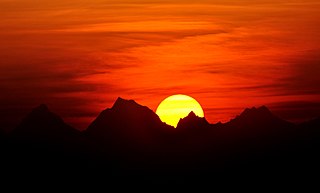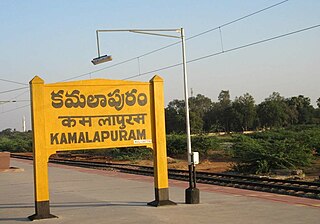
Sikkim is a state in northeastern India. It borders the Tibet Autonomous Region of China in the north and northeast, Bhutan in the east, Koshi Province of Nepal in the west, and West Bengal in the south. Sikkim is also close to the Siliguri Corridor, which borders Bangladesh. Sikkim is the least populous and second-smallest among the Indian states. Situated in the Eastern Himalaya, Sikkim is notable for its biodiversity, including alpine and subtropical climates, as well as being a host to Kangchenjunga, the highest peak in India and third-highest on Earth. Sikkim's capital and largest city is Gangtok. Almost 35% of the state is covered by Khangchendzonga National Park – a UNESCO World Heritage Site.

Namchi is a city and the administrative headquarter of the Namchi district in the Indian state of Sikkim. The appellation Namchi means Sky (Nam) High (Chi) in Sikkimese.
Gyalshing is a city, located in Gyalshing district, in the Indian state of Sikkim. It is administrative headquarter of district. The town is connected to the capital Gangtok by a metalled road. Geyzing is also connected to the West Bengal towns of Darjeeling and Kalimpong via Jorethang. A few kilometres north is the town of Pelling. The town has a large Nepali population, and the Nepali language is the predominant language of the region. The town is situated at an altitude of about 6,500 feet (1,900 m). The town enjoys a temperate climate for most of the year and snow sometimes falls in the vicinity.

Namchi District is a district of the Indian state of Sikkim. Its headquarters is at Namchi.

Darjeeling District is the northernmost district of the state of West Bengal in eastern India in the foothills of the Himalayas. The district is famous for its hill station and Darjeeling tea. Darjeeling is the district headquarters. Kurseong, Siliguri and Mirik, three major towns in the district, are the subdivisional headquarters of the district. Kalimpong was one of the subdivisions but on 14 February 2017, it officially became a separate Kalimpong district.
Tinkitam is a small town in Namchi, India. The town is located 45 minutes from the district headquarters Namchi. The town is being promoted as a tourist destination. Mount Kanchenjanga is near the town.
Bhagur is a municipal council in Nashik District in the state of Maharashtra, India. Bhagur is the birthplace of Indian independence movement revolutionary Swatantryaveer Vinayak Damodar Savarkar. It is located 4 km from Deolali and 22 km from Nashik city. Bhagur is a scenic town replete with lush, rolling hills and pleasant weather, all of which make it a great weekend getaway from Nashik. An hour-long drive promises splendid views of the hill range, as well as the verdant valleys laid out below. While you are in town, make some time for Bhagur Devi Temple, which attracts a large number of devotees. This small yet beautiful temple is a must-see for those who love offbeat attractions, and is a great way to get acquainted with warm locals and purohits of Bhagur. Seek blessings of the goddess as you explore the premises of the temple, or sit in the courtyard and grab a moment of peaceful meditation.

Singtam is a town which lies mostly in Gangtok District and partly in Pakyong District in the Indian state of Sikkim about 30 kilometres (19 mi) from the state capital Gangtok. The town lies on the banking of the rivers Teesta and Ranikhola, which join together just below the town. NH10 and NH510 meet in Singtam. The Indreni Bridge and Sherwani Bridge over the river Teesta are in the town. Singtam District Hospital, the district hospital of Pakyong District, lies at Golitar, Singtam.

Kausani is a hill station and Village situated in Bageshwar district in the state of Uttarakhand, India. It is known for its scenery and its 300 km-wide panoramic view of Himalayan peaks like Trisul, Nanda Devi and Panchchuli. Mahatma Gandhi called this place the 'Switzerland of India', due to similarity in landscapes.

Kamalapuram is a Town in YSR Kadapa district of the Indian state of Andhra Pradesh. It is located in Kamalapuram mandal of Kadapa revenue division and is the Thaluka headquarter of Kamalapuram assembly constituency.

Rabong or Ravangla is a small tourist town with an elevation of 8000 feet located, near Namchi City in the Namchi district of the Indian state of Sikkim. It is connected by state highway to other major towns in the state and lies between Namchi, Pelling and Gangtok. It is the starting point for the trek to Maenam Wildlife Sanctuary. It is approximately 65 km from the state capital, Gangtok, and 120 km from Siliguri, West Bengal. The name is derived from the Sikkimese language. ‘Ra’ means wild sheep, 'vong' translates to a rearing place, and ‘la’ means a pass.
Shivanoor is a village in Belgaum district of Karnataka, India. According to Census 2011 information the location code or village code of Shivanoor village is 597265. Shivanoor village is located in Athni Tehsil of Belgaum district in Karnataka, India. It is situated 13km away from sub-district headquarter Athani and 167km away from district headquarter Belgaum. As per 2009 stats, Jambagi is the gram panchayat of Shivanoor village.

Tendong Dichhen Salhun Gumpa or Tendong Gumpa as commonly known, is a Buddhist monastery situated atop 8530 ft. altitude from mean sea level (msl). This monastery is surrounded by lush green virgin reserve forest and nearest hamlet is Damthang which is at a six kilometer walking distance. Because of its seclusion, there are no resident monks/nuns in this monastery.
Lingmoo is a village in Namchi District of Sikkim, India. It is 50.4 km from Gangtok, capital of Sikkim. It falls under Ravangla sub-division. Lingmoo is divided into upper-Lingmo, Pepthang, Tokday, Kolthang, Mangzing, and blocks. Tokday has 265 households with population of 1,339, of which 680 are males and 659 are females as per Census 2011. Kolthang has 241 households with 1,249 population, of which 634 are males and 615 are females as per 2011 Census. Mangzing has 216 homes with 1,134 population, of which 599 are males and 535 are females as per Census 2011. A total of 59 families reside in Lingmo block as per Government of India 2011 Census. It has a population of 297, of which 161 are males and 136 are females as per 2011 Census. Lingmo has a literacy rate of 75.30%. The village has of mixed population of Hindus, Buddhists, and Christians. Male literacy stands at 80.43% and female literacy at 68.81%. The village is administered by Panchayat President. It lies within Yangang-Rangang constituency of Sikkim Legislative Assembly. Lingmo is divided into Mangzing, Kolthang and Tokdey blocks of the constituency.
Zarung is a village located in Namchi, India. It belongs to the Ravong Tehsil of Namchi.
Bikmat is a village located in the Sikkim state of India. The village belongs to the Namchi Tehsil of Namchi district.
Pacheykhani is a village located in Pakyong tehsil of Pakyong District in Sikkim, India. It is situated 7 kilometres (4.3 mi) from the district headquarters at Pakyong and 37 kilometres (23 mi) from the state capital Gangtok. The 2011 Census of India recorded it as having a population of 2264 of which 1164 were male and 1100 were female. According to the census 2011 the village code of Pacheykhani is 261340. The total geographical area of the village is 162.82 hectares. As per 2019 stats, Pacheykhani villages comes under Rhenock assembly & Sikkim parliamentary constituency. Rorathang is nearest town to Pacheykhani which is approximately 09 kilometres (5.6 mi) away.
Singling is a community in Sikkim, India. It has been on the trade routes between India and Bhutan since ancient times. A popular tourist activity is to trek between Barsey Rhododendron Sanctuary and Singling. There is an ancient monastery, a lake and amazing mountains. It is known for birding.
Godiyawas is a village in Sikar District, Rajasthan, India. Godiyawas village was founded by Shri Gaj Singh Shekhawat. Shri Gaj Singh Shekhawat was the son of Thakur Shyam Singh Shekhawat(Khoor King). Khoor King Shyam Singh ji granted Godiyawas village to the Kunwar Gaj Singh Shekhawat.
Darap is a census village in Gyalshing district, Sikkim, India. As per the 2011 Census of India, Darap village has a total population of 1,743 people including 901 males and 842 females.










